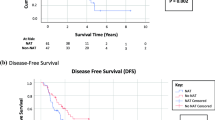Abstract
Background
Low-grade appendiceal mucinous neoplasm (LAMN) with peritoneal involvement is a common indication for cytoreductive surgery with heated intraperitoneal chemotherapy (CRS/HIPEC). With peritoneal recurrence, patients are increasingly being offered repeat CRS/HIPECs, however optimal timing for a second CRS/HIPEC remains unknown.
Methods
A prospectively maintained 30-year database at our high-volume HIPEC center was analyzed retrospectively for patients with LAMNs and peritoneal recurrence receiving one or two CRS/HIPECs. Kaplan–Meier survival analysis, linear regression modeling, and Cox proportional hazards regression analyses were performed.
Results
Overall, 143 patients with LAMNs who underwent CRS/HIPECs had confirmed postoperative peritoneal recurrence. Of these patients, 85 underwent one CRS/HIPEC and 58 underwent two CRS/HIPECs. The groups had significant differences in age, with younger patients more likely to undergo a second CRS/HIPEC (48.5 vs. 58.0 years; p < 0.001). The median overall survival (OS) for the group undergoing two CRS/HIPECs was approximately four times longer compared with the group undergoing one CRS/HIPEC (227.1 vs. 54.5 months; p < 0.0001). The time from recurrence to the second CRS/HIPEC was not significantly associated with OS from the time of the first operation. Instead, a shorter time between the first CRS/HIPEC and recurrence was significantly associated with shorter OS from the time of the first operation (p = 0.037).
Conclusion
In peritoneal LAMNs with recurrence, receiving two CRS/HIPECs was associated with better OS compared with receiving one CRS/HIPEC. Longer time to recurrence was a good prognostic factor. Delay between recurrence and second CRS/HIPEC had no apparent impact on OS from the first CRS/HIPEC; thus, immediate or delayed reoperative intervention are both reasonable approaches.




Similar content being viewed by others
References
Glehen O, Kwiatkowski F, Sugarbaker PH, et al. Cytoreductive surgery combined with perioperative intraperitoneal chemotherapy for the management of peritoneal carcinomatosis from colorectal cancer: a multi-institutional study. J Clin Oncol. 2004;22:3284–92.
Yan TD, Black D, Savady R, Sugarbaker PH. A systematic review on the efficacy of cytoreductive surgery and perioperative intraperitoneal chemotherapy for pseudomyxoma peritonei. Ann Surg Oncol. 2007;14:484–92.
Chua TC, Moran BJ, Sugarbaker PH, et al. Early- and long-term outcome data of patients with pseudomyxoma peritonei from appendiceal origin treated by a strategy of cytoreductive surgery and hyperthermic intraperitoneal chemotherapy. J Clin Oncol. 2012;30:2449–56.
Levine EA, Stewart JH, Shen P, Russell GB, Loggie BL, Votanopoulos KI. Intraperitoneal chemotherapy for peritoneal surface malignancy: experience with 1,000 patients. J Am Coll Surg. 2014;218:573–85.
Sadeghi B, Arvieux C, Glehen O, et al. Peritoneal carcinomatosis from non-gynecologic malignancies: results of the EVOCAPE 1 multicentric prospective study. Cancer. 2000;88:358–63.
Chua TC, Yan TD, Saxena A, Morris DL. Should the treatment of peritoneal carcinomatosis by cytoreductive surgery and hyperthermic intraperitoneal chemotherapy still be regarded as a highly morbid procedure? A systematic review of morbidity and mortality. Ann Surg. 2009;249:900–7.
Chua TC, Quinn LE, Zhao J, Morris DL. Iterative cytoreductive surgery and hyperthermic intraperitoneal chemotherapy for recurrent peritoneal metastases. J Surg Oncol. 2013;108:81–8.
Choudry HA, Bednar F, Shuai Y, et al. Repeat cytoreductive surgery-hyperthermic intraperitoneal chemoperfusion is feasible and offers survival benefit in select patients with peritoneal metastases. Ann Surg Oncol. 2019;26:1445–53.
Konstantinidis IT, Levine EA, Chouliaras K, Russell G, Shen P, Votanopoulos KI. Interval between cytoreductions as a marker of tumor biology in selecting patients for repeat cytoreductive surgery with hyperthermic intraperitoneal chemotherapy. J Surg Oncol. 2017;116:741–5.
Tokunaga R, Xiu J, Johnston C, et al. Molecular profiling of appendiceal adenocarcinoma and comparison with right-sided and left-sided colorectal cancer. Clin Cancer Res. 2019;25:3096–103.
Levine EA, Votanopoulos KI, Qasem SA, et al. Prognostic molecular subtypes of low-grade cancer of the appendix. J Am Coll Surg. 2016;222:493–503.
Oken MM, Creech RH, Tormey DC, Horton J, Davis TE, McFadden ET, Carbone PP. Toxicity and response criteria of the Eastern Cooperative Oncology Group. Am J Clin Oncol. 1982;5:649–55.
Jacquet P, Sugarbaker PH. Clinical research methodologies in diagnosis and staging of patients with peritoneal carcinomatosis. Cancer Treat Res. 1996;82:359–74.
Moaven O, Su J, Jin G, et al. clinical implications of genetic signatures in appendiceal cancer patients with incomplete cytoreduction/HIPEC. Ann Surg Oncol. 2020;27:5016–23.
Canbay E, Ishibashi H, Sako S, et al. Preoperative carcinoembryonic antigen level predicts prognosis in patients with pseudomyxoma peritonei treated with cytoreductive surgery and hyperthermic intraperitoneal chemotherapy. World J Surg. 2013;37:1271–6.
Mangieri CW, Valenzuela CD, Erali RA, Votanopoulos KI, Shen P, Levine EA. Incidence, risk factors, and outcomes from conversion of low-grade to high-grade appendiceal neoplasms for patients undergoing multiple cytoreductive surgeries with hyperthermic intraperitoneal chemotherapy. Ann Surg Oncol. 2022;29(1):205–11.
Votanopoulos KI, Mazzocchi A, Sivakumar H, Forsythe S, Aleman J, Levine EA, et al. Appendiceal cancer patient-specific tumor organoid model for predicting chemotherapy efficacy prior to initiation of treatment: a feasibility study. Ann Surg Oncol. 2019;26:139–47.
Funding
This work was supported in part by The Smith Family Fund and the Wake Forest University Comprehensive Cancer Center Biostatistics Shared Resource funded via the NCI grant award P30CA012197.
Author information
Authors and Affiliations
Corresponding author
Ethics declarations
Disclosures
Cristian D. Valenzuela, Christopher W. Mangieri, Mary Garland-Kledzik, Rohin Gawdi, Gregory Russell, Kathleen C. Perry, Konstantinos I. Votanopoulos, Edward A. Levine, and Perry Shen declare no conflicts of interest.
Additional information
Publisher's Note
Springer Nature remains neutral with regard to jurisdictional claims in published maps and institutional affiliations.
Supplementary Information
Below is the link to the electronic supplementary material.
Rights and permissions
About this article
Cite this article
Valenzuela, C.D., Mangieri, C.W., Garland-Kledzik, M. et al. Timing of Repeat Cytoreductive Surgery with Hyperthermic Intraperitoneal Chemotherapy for Recurrent Low-Grade Appendiceal Mucinous Neoplasms. Ann Surg Oncol 29, 3422–3431 (2022). https://doi.org/10.1245/s10434-022-11440-4
Received:
Accepted:
Published:
Issue Date:
DOI: https://doi.org/10.1245/s10434-022-11440-4




